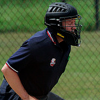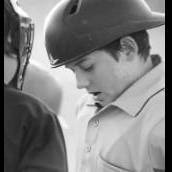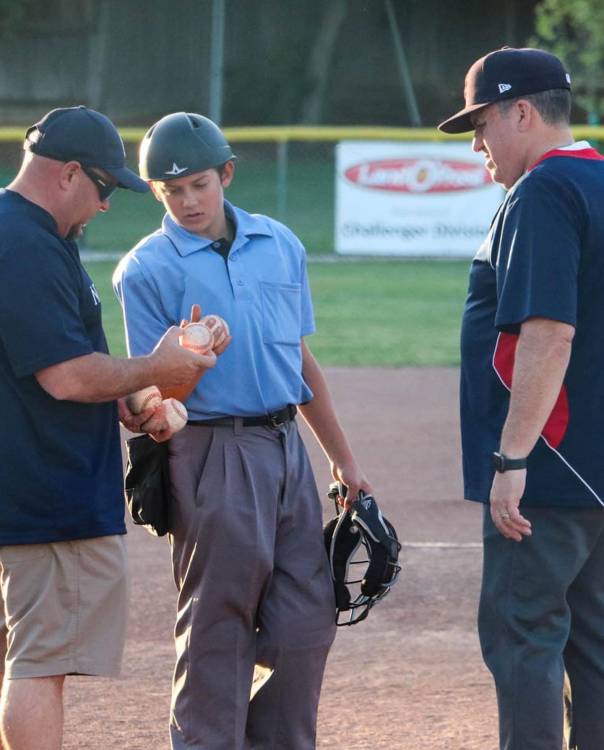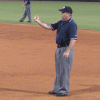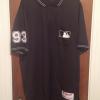Leaderboard
Popular Content
Showing content with the highest reputation on 04/11/2022 in all areas
-
I believe you saw the 'skunk in the outfield' play. My understanding is guidance is that it is completely legal (see this article: https://austinumpires.org/skunkplay.html), but umpires should be careful to ensure that R1 travels directly to one of the bases "when a play is being made on him". I've seen references to this play in the past that claimed that NFHS guidance is that this is NOT a "travesty of the game", and to let it play out.5 points
-
I don't see any part breaking the back plane from that angle but OBR only addresses the free foot. That was a step balk. I know because I just called one this week in HS from the "B" position. How this works is I and the MLB umps miss the first one and then ask themselves how did that runner get picked off so easily. Then we decide to focus on the step and call the second one. Then the pitcher stops using that move because the offensive coach, knowing that the balk call and the judgment of the step is hit or miss, is chewing on his R1s to stay closer.3 points
-
I don't want you, whether you're the coach, umpire, or fan in the stands, to be sympathetic to me. I want that coach to stop wasting my time. Get on with the damned ball game and stop trying to come up with every stupid tactic imaginable to use R1 to score R3. I can counter it, and I have countered it. At all age and skill levels. To such a coach my response is: Stop wasting my time "coach" and teach your hitters to hit...then you won't have to worry about ridiculous tactics to score a cheap run. Like I said before, I'll give you the damned run if you want it so bad...I'll gladly take the free out you just gave me. My players can hit, so if you can counter the 12 runs I'm gonna shove down your throat by giving me a free out every time you have R1/R3, go for it. And it's bush league because it's a tactic that only works against SH*#ty teams...and 99.99999% of the time they don't need the tactic, because their opponent is that SH*#ty. It's not smart coaching...it's beating up/bullying a weaker team. Worse, any coach who calls this crap is not doing their players any favors...when running this kind of play they are not learning ANY skills that they can retain and develop that will help them in the future. Teach your kids to hit. Teach them how to effectively run bases. Teach them the skills they'll need as they advance. Teaching this crap is just a waste of time, and only serves a coach who wants to win at all costs.2 points
-
We usually just play the facing, or fascia board of the dugout as live and in play. Some of the dugouts are constructed of block, and some parts of the block wall that faces the field are usually in play, too. If the ball goes into the dugout and hits the back wall, or the bench, or anything else in the dugout proper, then it's a dead ball. It's just a matter of what you're defining as dead or live ball territory. I just think of it as being a chain link fence covering the dugouts in many of the fields today. If it bounces off the chain link and stays in play, live ball. If it penetrates into the dugout, then dead ball. Hope that makes sense.2 points
-
This is a huge umpiring milestone for me. I've been hired to umpire in the Pecos League (independent minor league) this summer! I know it's a shoestring operation, but it's a step up from high school and therefore I'm counting it as progress. I'm trying to break into collegiate umpiring, but unfortunately Pecos is mandating that we use a 2-man system. I know collegiate ball uses 3-man, but I figure it's at least a step in the right direction.2 points
-
He can lead off wherever he wants. There’s no out of the basepath until the defense makes a play on the runner. When the defense makes a play on him, now the runner must stay within a 3 feet of his path.2 points
-
No. (This has been asked multiple times recently--to be fair, it might have been elsewhere once or twice; apparently, it's the question of the year. At least it's a change from "does the run score when the third out is an appeal because the runner was "forced" to return to the base)2 points
-
That's exactly how runners should be coached. Failure to avoid (a stationary) F2 makes the runner liable for MC. I put that burden of avoiding contact on the runner. He's got F2 in front of him and nothing better to look at. F2 is looking for the ball and can't read the runner's path. When I was teaching our class, I made a point of this safety rule: we want runners to avoid catchers, even those who are guilty of OBS. If we DON'T call the OBS, we're giving catchers a huge advantage in plays at the plate. If F2 is moving to field the throw and drifts into the runner's path, that collision is nothing but a train wreck (but possibly still OBS, depending on when F2 gets the ball). All that said, I can't determine from your description whether OBS or MC is the better call here. It's probably not nothing, because the runner was affected by F2's position before the ball arrived. That puts OBS on the table. But if the runner deviated into F2, then I've got MC, which supersedes OBS by rule. Definitely need to be at 3BLX to read all this.2 points
-
1 point
-
Now that's the attitude I can get behind! Bravo! 12 runs is exactly the kind of production we need to get to a Run Rule. Yay! Umpires everywhere will applaud you (and your team)!1 point
-
How is this "bush league"? If you don't have a pitcher who can reliably throw a strike, a catcher who can reliably catch, and/or an infield who can't retain its composure and react to a play in an effective (read: error-free) manner, then how am I – as an opponent, umpire, or baseball enthusiast – expected to be sympathetic to you?? I'm at a breaking point – wit's freakin' end, and only my mask is sometimes obscuring the contempt on my face – in amateur baseball wherein a defensive team gets into a R1-R3 situation, and just implodes. The coaching staff implores the catcher to (oh! call Time first!) step out in front of the plate, go thru all these complex signals and semaphores that resemble trying to land an aircraft on a WWII escort carrier, in a crosswind, or WORSE! call out this numerical code that all fielders have to consult their wrist card about... and then on the first f'ing pitch they completely f*#k it up by: F1 throwing the pitch to the backstop F2 throwing his throw over or wide of 2B F4 / F6 completely forgetting to cover 2B F1 snaring F2's return throw, and then spinning to throw it wide of 3B F2 elaborately faking his throw, and double-clutching to instead throw to 3B... five feet over F5's head. F2 elaborately faking his throw, ignoring R1 completely, and go... ridiculously... running after R3 looking like a Tin Can Knight (side: I'm starting to deduce that the success of an amateur baseball team is directly linked to the condition and fit of the F2's gear). So if a little-known, off-the-backpage play situation like the "skunk in the grass" is enough to show how utterly deficient a team – and ultimately, how unprepared or coached – is at handling these scenarios, then I say have at it.1 point
-
Please, please, please, if you're going to umpire, know the difference between obstruction and interference.1 point
-
I EJ’d a kid this weekend for the very same. No OBS, kid was out by 5-6 full steps. Put both arms up and laid out the catcher. Simple call. Coaches were up in arms b/c I ran him. “He can’t slide, what’s he supposed to do?” Coach couldn’t get it in his head plowing the catcher isn’t an approved alternative.1 point
-
Of course it (your association) does, everybody prefers the Majestics over the Smittys. They were discontinued in 2019, but no-one really noticed because there were many other "big things" going on, and we (as a culture) were on the precipice of a global panic attack. Majestic did not go out of business; instead, they left their relationship with Major League Baseball. Majestic's parent company was VF Mills (read on Wikipedia) until 2017. One of the greatest advantages that Majestic had over other similar producers was its access to source material developed or cultivated by its sibling brands under the parent brand. CoolBase and ThermaBase came out of this relationship. In 2015, Majestic had brokered a deal to cultivate and produce their latest formulation of CoolBase fabric, and really really wanted to showcase it on the uniforms of their biggest client – MLB. So, all the ballplayers and staff got new gear. The umpires, however, presented a strong resistance to change (as umpires are prone to do). Since it couldn't be agreed to what a new style would look like, and with Majestic saddled with a substantial stock of material and production lines queued up ready to work, Majestic was forced to produce 2 models of shirt to "use up" the material they already had ready to go: hence, the 2015 "Plain Black" shirt, which if you look at the details of it (or own one), has all the features that the eventual 2016 Panel-style shirts exhibited, as well as a "button garage" that wasn't included on the forthcoming models; and a "traditional" navy w/ red-&-white trim shirt, hoping to appeal and capture sales from the HS and American Legion markets. Damn, are we (umpires) stubborn. During 2015, Majestic's design staff and MLB Umpires actually got together and developed the details of the styles that would become the 2016 models. The "heat panels" that are not only on the flanks but also at the tail were significant design inclusions, as was the alteration of the shade of sky blue to create better contrast (white ball against blue) and (hopefully) mask sweat color shift "better". Until 2015, Majestic's contract with MLB had been renewed every five years; indeed, the 2010 umpire shirt (vertical stripe) model had lasted 5 years, and only because MLB had not been prepared for / amenable to a new design style did the "plain black" have to be produced. It was anticipated that the 2016 Panel styles would last another 4-5 years... Which would bring us to 2020. But then, 2019 happened. Major League Baseball had already been courting a larger "super brand" to takeover the contract, and by all indications, it was going to be UnderArmour, which would have made MLB rather happy, since the NFL had landed Nike, and this would have set up a competing-&-contrasting brand and marketing relationship. But then, some time in late 2018 – early 2019, UA balked at the deal and withdrew from the process. So instead, the contract was assumed by Nike. And, true-to-form in Nike's ways and ethos, they started to crank out some rather... progressive design styles for the uniforms and staff-wear. In regards to the umpires, though, I ~think~ (I have no way of confirming this) the dreamy-eyed designers from Nike hit that same wall; their proposed styles were way too "out there" for the likes of the MLBU's core staff. As such, the umpires continued to use "old new stock" of the current panel style shirts and jackets. Perhaps an entire new-style campaign was formulated and the 2020 pandemic squashed it, and then with the Labor Dispute rushing up from the horizon, any further rollout ideas were put on hold. In any case, for 2022, MLB is still using "new old stock" of shirts and jackets, but I don't think this supply is going to last much longer. We will likely see a new, comprehensive style campaign rollout in 2023. With that said... that puts second (and third) -tier producers like Smitty's, Honig's, Adams (officials-division of Schutt), and Cliff Keen (yech) in a quandary. In all bat-sports officiating, everybody bases their uniform decisions off of whatever Major League Baseball does or is doing. Softball and NFHS Baseball – famously – sets their uniform standards to not look like the Big League guys!! Either ya wanna look like 'em, or ya don't. The majority of the umpire market wants to look like the Big League guys; thus, if you're a producer, you are almost compelled to produce a "MLB Replica". However, with that eventual style changeover looming ever closer, you don't want to go "all in" and be stuck with little-wanted / unwanted stock when the entire market is awaiting the new style debut. The NCAA was "stuck" using the 2010 Vertical-stripe style for the opening rounds (Regionals) of the College World Series postseason because they had stockpiled an overabundance of Vertical-stripe style shirts with the NCAA patch applied. Smitty's has seized upon this tempestuous time and brokered some substantial deals and contracts to supply various entities. Their shirts and pants are what the MiLB guys use. The other producers are just "treading water", producing only enough supply to stay relevant and competitive until Nike & MLBU debuts the eventual new style. Cliff Keen continues to produce the crap they do because the NFHS (which I think is an acronym for "No F*#king Handle on Style") folks in Indianapolis will just not let go of that one line in their rulebook – "barring state association direction, the shirt shall be a navy pullover" (paraphrased).1 point
-
This is exactly what you should be doing...coming from a former competitive player, and a club coach. You have to trust the umpire to get it right. And if you don't...really? Your decision and approach is to take the path that most risks injury to you, the catcher, or both? For a F*#King run? In an amateur ball game? Really? Get that out of your head now...and get it out of the head of any player or coach you know. And, from experience, if you deviate your path around the catcher, 9 out of 10 umps get it right...the other one...well, he's not getting much else right either so this play is the least of your worries. Most umps, if they see the collision, they're blaming the runner, especially if F2 was parked, as opposed to a last second move.1 point
-
Sure, it's legal, but I wish coaches who teach/call/encourage this SH*# would be beaten with a rubber hose. It's not baseball. It's below bush league. At that same time, F1 should just throw to F4 who is in front of the runner...if that runner makes any move towards the outfield, he's out...then spin and throw home. Frankly, if they're at a level where F4 can't throw out R3 at home, then R3 is probably scoring anyway, take the free out. Outs are the most precious commodity in the game...if the other team wants to give them away, let them.1 point
-
As described and if I'm understanding the question correctly, I have a fair ball. A fly ball that first lands in fair territory beyond first base or third base, is a fair ball. Doesn't matter the trajectory of it, just where it first lands. You can find the definition of a fair ball in most rule books under Definition of Terms. Usually Rule 2.00 in OBR and Little League, and Rule 2 in FED (high school rules).1 point
-
We have very similar situations at many of the High Schools in our area. All of them have the ball live and in play if it hits the wood/block/whatever. Very common ground rule in our area. Never had an issue.1 point
-
A strict reading seems to indicate that the managers can agree on any ground rules. If they can't agree, then the umpire makes the ground rules and these (made by the umpire) cannot conflict with playing rules: The manager of the home team shall present to the umpire-in-chief and the opposing manager any ground rules he thinks necessary covering the overflow of spectators upon the playing field, batted or thrown balls into such overflow, or any other contingencies. If these rules are acceptable to the opposing manager they shall be legal. If these rules are unacceptable to the opposing manager, the umpire-in-chief shall make and enforce any special ground rules he thinks are made necessary by ground conditions, which shall not conflict with the official playing rules.1 point
-
I'm not sure if the pay is public. Let's just say it's better than high school and not as good as college. They are hiring guys in specific areas to cut their travel costs, so I'll be in Colorado Springs, Trinidad, and Roswell. The league covers a much bigger area than that, but they will have guys in each area to cover the umpiring. We will get a travel stipend and they put us in a hotel for games in the same place for multiple days in a row. We will not be working with the same partner all the time, as availability is the #1 reason assignments are made. Training: No, unfortunately. They grabbed the best guys from our high school association, and I've noticed the vast majority of us who were selected have all gone to umpire clinics and don't want to rely on the association's training as our only training. Our initial training program for new umpires is awesome for a high school association, but we do not have a mentorship program or evaluation program to continue to improve. Once you're released to umpire, it's all on you. Those of us who take it seriously go to clinics.1 point
-
1 point
-
The explanation is that lefties get away with murder and the runner's coach didn't remind him of that.1 point
-
From the 2016 Baseball Rules Differences by Carl Childress (section 454, p. 301): Runner Establishes Base Path FED: When a play is being made on a runner, he establishes his base path as a direct line between his position and the base he is trying for. (8-4-2a-2) Official Interpretation: Hopkins: The “skunk in the outfield” is legal. A runner may lead off any way he likes toward the next base and is not guilty of an infraction unless he uses more than three feet on either side of his base path to avoid a tag. (Website 2000 #20; affirmed, website 2005 #16) NCAA and OBR: Same as FED. OBR Official Interpretation: Wendelstedt: A runner may lead off in any manner he wishes, including as far into the outfield as he’d like. The only restriction involves first: If BR runs through first, he is required to return to it before taking his lead. He may not remain out in the outfield and “lead off” from that position or attempt to draw a throw from the defense to allow other runners to advance. 2000 SITUATION 20: With R3 on third base, R1 takes a lead off of first base and positions himself at the grass behind first base down the right field line. F1 throws to F3 in an attempt to pick off R1. R1 runs down the right field foul line toward the outfield fence. RULING: While R1’s position is legal, he is declared out when he ran toward the outfield fence when a play was attempted. In running down the foul line, he was out of the baseline he had between his position at the time of the pick off and second base. (8-4-2a) 2005 SITUATION 16: With R3 on third base, R1 takes a position about three feet in the grass behind first base. The pitcher, in a pick-off attempt, throws to first base and R1 runs directly from his position to second base. The defensive coach argues that this is an unfair tactic and that R2 should be declared out. RULING: While a runner may not position himself behind a base to get a running start, there are no other restrictions as to where a runner must be when taking his lead from a base. From wherever he positions himself, his baseline is established from that point directly to the base toward which he is attempting. As long as he does not run more than three feet away from that direct line to avoid being tagged when a play is being made on him, his action is legal. (8-2, 8-4-2a Note, 8-4-2o)1 point
-
If the runner's path is altered by a fielder who is not in possession of the ball, obstruction would be the proper ruling. Based on the words provided, the runner altered his route to the plate by slowing down because F2 was in front of the plate awaiting the ball. Had F2 not been blocking the path to the plate the runner would likely have arrived prior to the ball. The way this play has been presented I would probably have obstruction on F2 in a game played under Fed rules.1 point
-
You should not have "found this", you should have known, been trained that this is a rule, as is a few others that apply to your play. Another one you might find as, I'm guessing, you first peruse the rule book, would be the runner not legally attempting to avoid a fielder in the immediate act of making a play on him. Of course timing is at issue here but a fielder with the ball can not be guilty of obstruction. But the outfit that put you on the field can be guilty of not preparing you. Did you find your cite in the rulebook they gave you. If so, 3 pages every BM will do you good but still leave some confusion that UE can clear up or your outfit should be able to also.1 point
-
Sounds like to me you haven't flipped the switch from player to umpire. Coach, player, umpire. If you combine any of the three it will go to s@#t.1 point
-
Offense interferes. Defense obstructs. Interference would be an out. If F2 was parked in the runner’s path to the plate without the ball and the the runner needed to alter is path to the plate, that’s Obstruction. Runner safe. If that runner saw F2 in his path and made no effort to avoid him and trucked him, I’ve got a strong hunch MC runner out and EJ would he the proper call. Have to see it.1 point
-
he was standing in front of the batters box up the line without the ball the entire time?, and we are of course talking about obs found this If the catcher is blocking the plate without possession of the ball and the runner makes contact with the catcher before touching the plate, obstruction should be called and the runner is awarded home plate. This would be the ruling even if the runner pushes the catcher out of the base path, as specified in the NFHS casebook. If the runner’s push was malicious, however, he would be ejected and the run would not count1 point
-
1 point
-
Kick ass! Go there and do the best damn job you can do and you'll be well on your way! Congratulations!1 point
-
all good ...... bottom line ...I thought this one particular question was clear and concise enough where it could be locked (not locked in a negative way) ... but .... with what came of this, and the reactions I received, I agree I shouldn't have. And again, I appreciate you guys bringing it to my attention.1 point
-
I almost placed one today, but then it was going to be $17.99 shipping on an almost $200 order so I passed. How do companies hope to survive by charging shipping fees when others are free after $99-129 orders? Ump-Attire is cheaper, faster and offers free returns which makes it hard to shop anywhere else. Further, they have most items in-stock while others are very low. The only issue is some state items (OHSAA) cannot be bought at Ump-Attire, so we have to keep dealing with other companies as well. I do like Purchase Officials as well. I never have to wait more than 2-3 days max for in-stock items, but then I'm 2 hours away from their OH headquarters.1 point
-
IMO, they lost their North as a company as can be seen in the comments on their social media pages about customer service. It is a hit or miss, all depends on how they wake up that morning. Sent from my SM-G960U using Tapatalk1 point




